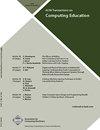基于视频的软件工程师面对面沟通技巧培训的有效性:来自三年研究的证据
IF 3.2
3区 工程技术
Q1 EDUCATION, SCIENTIFIC DISCIPLINES
引用次数: 0
摘要
目标。沟通技巧对于有效的软件开发团队来说是至关重要的,但是这些技巧很难教。我们项目的目标是评估使用AVW-Space教授面对面沟通技巧的有效性,AVW-Space是一个基于视频的学习平台,提供个性化的推动,以支持学生在观看视频时的参与。参与者。我们研究的参与者是二年级软件工程专业的学生。这项研究进行了三年多,学生们参加了一个学期的项目课程。学习方法。我们进行了一项为期三年的准实验研究,使用基于视频的学习平台AVW-Space教授面对面交流。以我们开发的AVW-Space为例,进行面对面交流教学。参与者观看并评论了10个视频,然后评论了他们自己的团队会议记录。在2020年,参与者(n = 50)没有收到轻推,我们使用当年收集的数据作为对照。在2021年(n = 49)和2022年(n = 48),采用自适应推送,鼓励学生撰写更多、更高质量的评论。发现。这项研究的结果显示了“轻推”的有效性。我们发现,当提供轻推时,参与程度有显著差异。此外,轻推对互动时间、撰写评论总数和高质量评论数量以及学习都有因果影响。最后,接触轻推的参与者报告了更高的感知学习能力。结论。我们的研究表明,在使用AVW-Space教授面对面沟通技巧的实例时,轻推对学生参与和学习的影响。未来的工作将探索其他软技能,并为AVW-Space的决策提供解释。本文章由计算机程序翻译,如有差异,请以英文原文为准。
Effectiveness of Video-based Training for Face-to-Face Communication Skills of Software Engineers: Evidence from a Three-Year Study
Objectives . Communication skills are crucial for effective software development teams, but those skills are difficult to teach. The goal of our project is to evaluate the effectiveness of teaching face-to-face communication skills using AVW-Space, a platform for video-based learning which provides personalized nudges to support student's engagement during video watching. Participants . The participants in our study are second-year software engineering students. The study was conducted over three years, with students enrolled in a semester-long project course. Study Method . We performed a quasi-experimental study over three years to teach face-to-face communication using AVW-Space, a video-based learning platform. We present the instance of AVW-Space we developed to teach face-to-face communication. Participants watched and commented on ten videos, and later commented on the recording of their own team meeting. In 2020, the participants (n = 50) did not receive nudges, and we use the data collected that year as control. In 2021 (n = 49) and 2022 (n = 48), nudges were provided adaptively, to encourage students to write more and higher-quality comments. Findings . The findings from the study show the effectiveness of nudges. We found significant differences in engagement when nudges were provided. Furthermore, there is a causal effect of nudges on the interaction time, the total number of comments written and the number of high-quality comments, as well as on learning. Finally, participants exposed to nudges reported higher perceived learning. Conclusions . Our research shows the effect of nudges on student engagement and learning while using the instance of AVW-Space for teaching face-to-face communication skills. Future work will explore other soft skills, as well as providing explanations for the decisions made by AVW-Space.
求助全文
通过发布文献求助,成功后即可免费获取论文全文。
去求助
来源期刊

ACM Transactions on Computing Education
EDUCATION, SCIENTIFIC DISCIPLINES-
CiteScore
6.50
自引率
16.70%
发文量
66
期刊介绍:
ACM Transactions on Computing Education (TOCE) (formerly named JERIC, Journal on Educational Resources in Computing) covers diverse aspects of computing education: traditional computer science, computer engineering, information technology, and informatics; emerging aspects of computing; and applications of computing to other disciplines. The common characteristics shared by these papers are a scholarly approach to teaching and learning, a broad appeal to educational practitioners, and a clear connection to student learning.
 求助内容:
求助内容: 应助结果提醒方式:
应助结果提醒方式:


